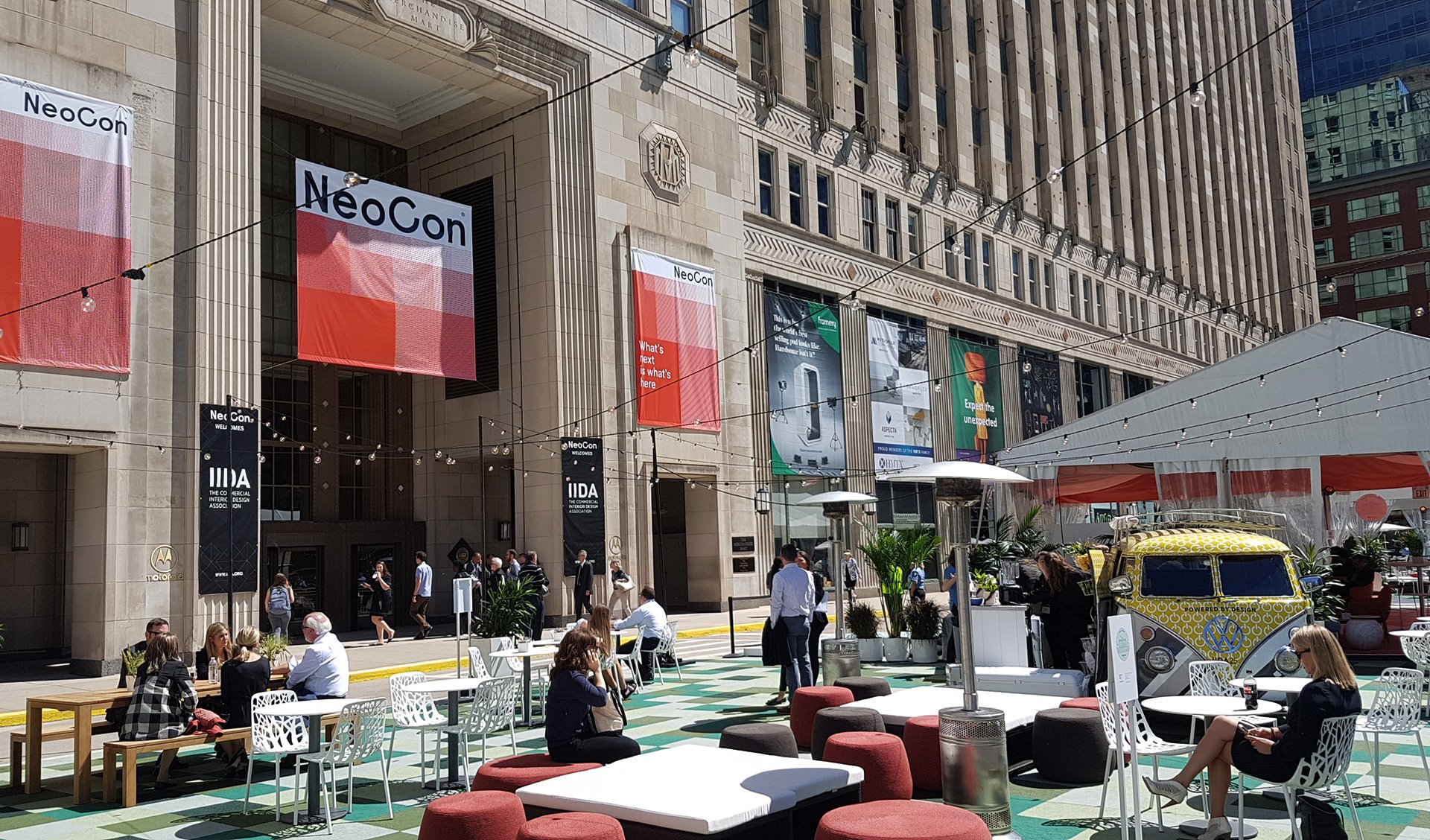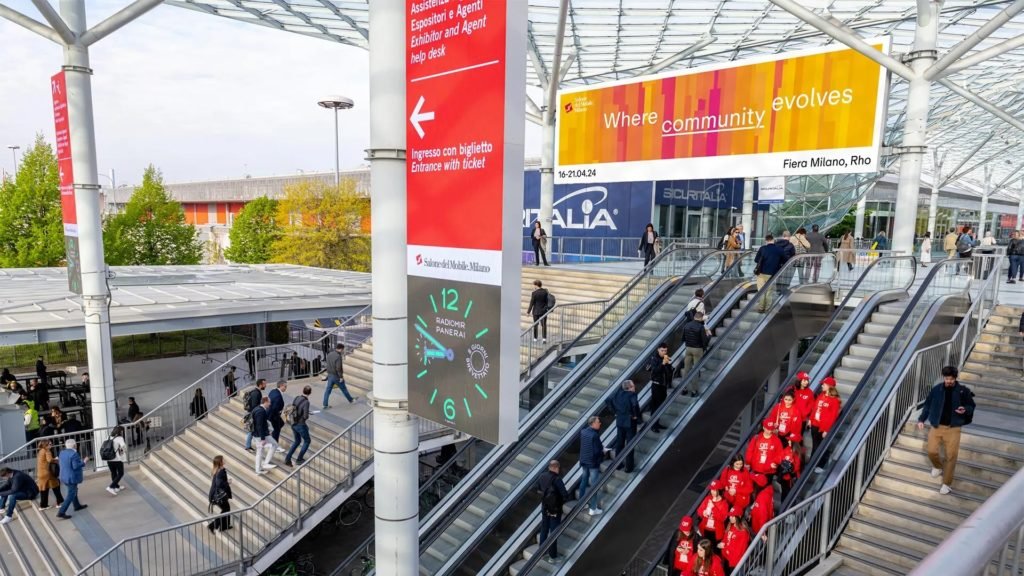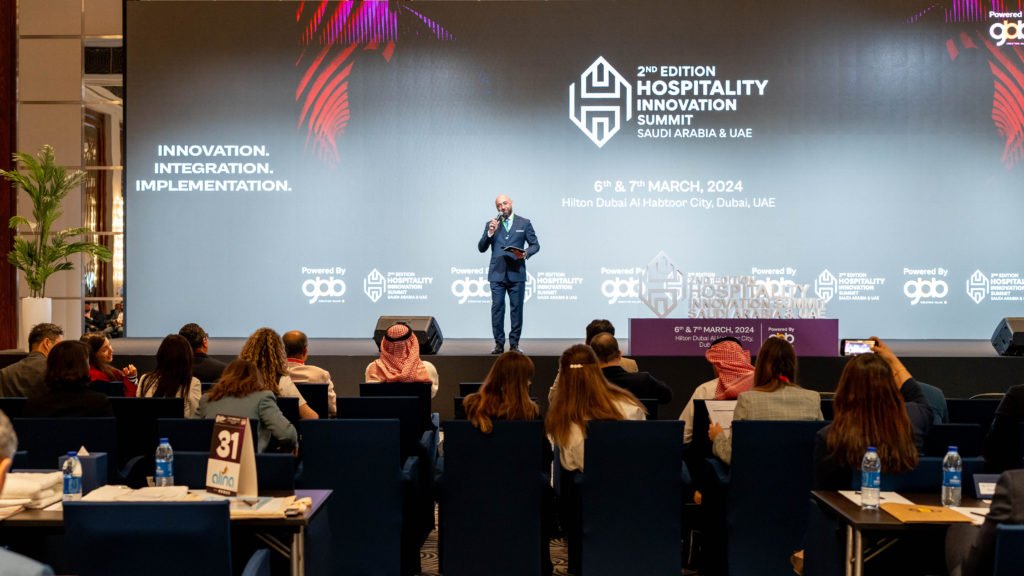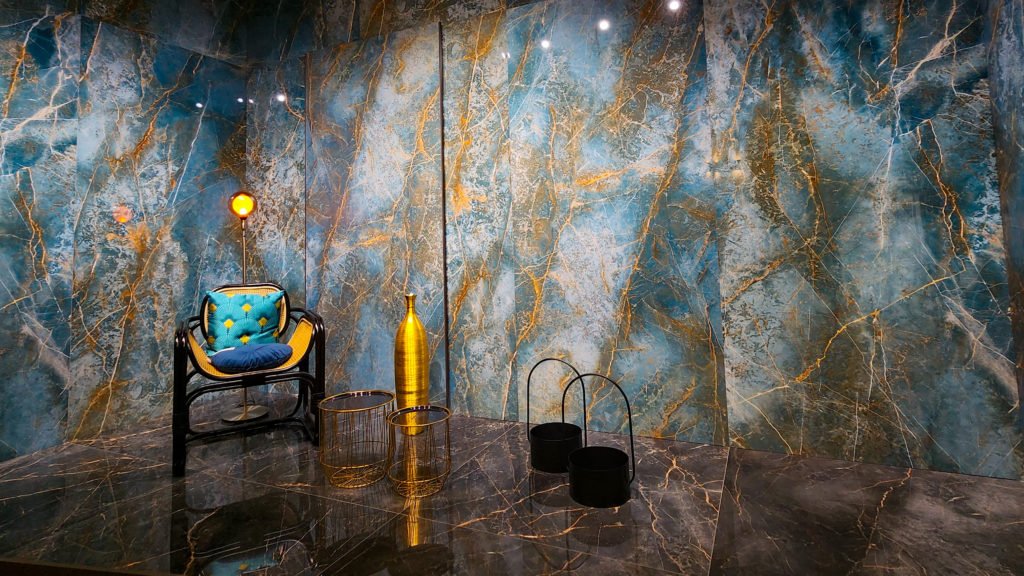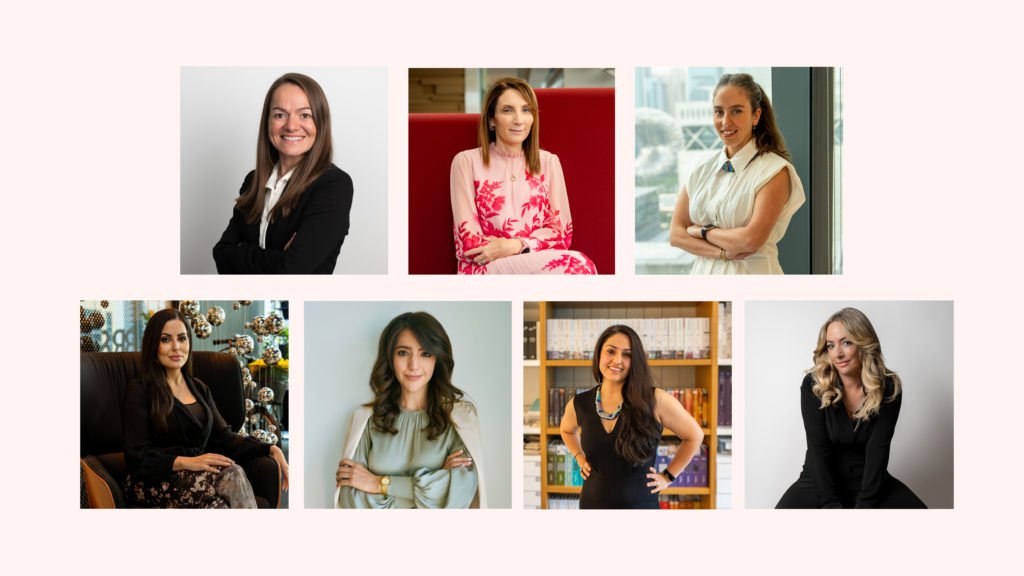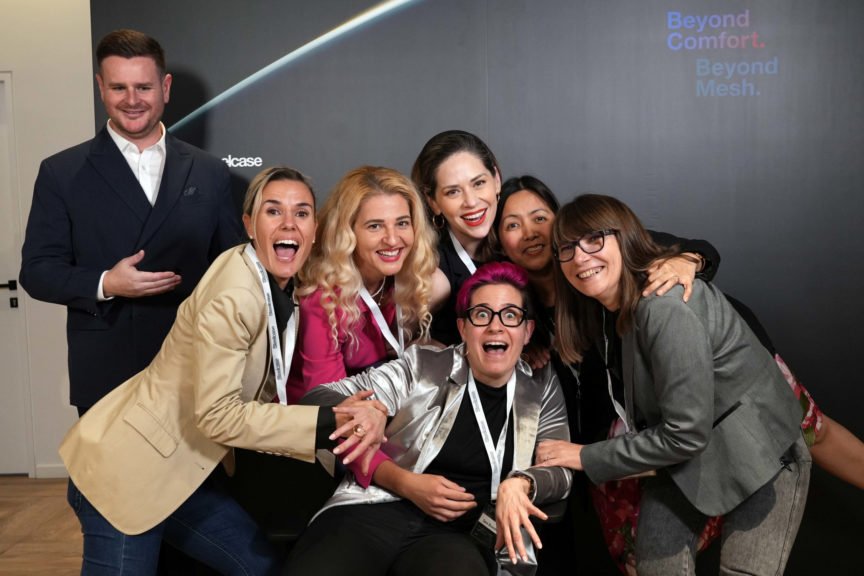Chicago’s historical Merchandise Mart, the stately, 25-floor, art deco structure in the heart of downtown, has played host to NeoCon every June since 1969. This year, 500 companies showcased thousands of products to celebrate NeoCon’s 51st year as an innovative leader in shaping the future of design.
Our experience of this massive design show was rich and diverse. We sat down with the minds of PearsonLloyd to understand how they design and collaborate, and spoke with industrial design legend, Don Chadwick, about ergonomic-forward design that doesn’t sacrifice style. A staggering 60,000 square feet of furniture filled the carefully curated outdoor Social Spaces alone! Meanwhile, the riverside pavilion was transformed into a Beach Bar, Work Lounge, and Café, and equipped with Haworth’s Maari chairs, and the park was outfitted with Janus et Cie lounge pieces. Both the permanent showrooms and temporary exhibitions gathered collections along three key themes: collaborative, comfortable and flexible spaces.
Above: Haworth’s Social Spaces
Trend Spotting
Semi-private Spaces
Trendy open plan offices have replaced sectioned off work spaces in recent years, but businesses seem to be backtracking as some believe that the trend creates noisy distractions and a lack of privacy needed for phone calls or meetings. It takes an average of about 25 minutes to return to a productive task after an interruption, which is why pods were everywhere at NeoCon 2019. From phone booths to conference rooms, modular systems offer flexible privacy in a world that’s still moving away from fixed offices.
Framery’s meeting pods really stood out with the Framery 2Q winning a silver Best of NeoCon award for acoustic privacy in modular solutions. The coloured frames and rounded edges made the spaces feel warmer and more personal than many of the other pods at the show. On the first floor, Framery featured their Oasis of Happiness installation, which was framed by futuristic design by artist Joshua Vides of “Reality to Idea” fame. The installation won the Small Booth award, presented by the International Interior Design Association (IIDA) and Contract Magazine, recognising the black and white print for originality of design, visual impact, effective use of materials, and outstanding use of space, colour, texture, lighting and graphics.
Above: Framery meeting pods and the award winning, monochromatic Framery 2Q
Companies, such as OFS, offered their own take with the Obeya line of framed cubicle style spaces constructed from light wood in an airy Scandanavian design. Slatted dividers, like the Marketplace frames, took centerstage in Herman Miller’s ‘All Together Now’ showroom, and curtains offered flexible privacy, both in these framed spaces and as standalone elements hung from the ceiling. The Herman Miller showroom also showcased thick, sangria coloured, velvet curtains that instantly transformed the space into a posh setting.
Privacy-forward seating was everywhere, and designs had acoustics, comfort and the mobile work station in mind. OFS’s LeanTo line allows employees to seek shelter in a more casual, and cozy, space. There were many examples of framed couches, with padded walls separating temporary inhabitants from their neighbours, but the LeanTo design took overhead noise into account, which made a significant impact. (Both LeanTo and Obeya won Gold Awards from Contract Magazine for Best of NeoCon.)
Above: OFS and its award winning LeanTo; Herman Miller’s plush spaces with velvet curtains; Boss Design’s booth
Technology meets Biophilia
NeoCon 2019 housed plenty of sofas, cabanas and desks built with mobile devices in mind, but also revealed the trend of utilising our high-tech lifestyle to make indoor spaces (where the average person spends 90 percent of their time) feel more natural.
Teknion’s Sanna Lightbar by Pablo goes from ‘cloudy’ to ‘sunny’ when the user moves their head across the top of its sleek structure. Dyson’s LightCycle Task Lamp comes with a 60-year warranty, and links to the user’s phone, adjusting the light to match the lighting outside, allowing you to reconnect with your circadian rhythm. This bio-forward technology earned Dyson an Honoree status for Interior Design’s HiP Award.
Above: Dyson LightCycle and Teknion’s Sanna Lightbar
Bold and Monochromatic
A forest green couch with a sage green pillow, a mustard yellow one with metal legs to match – monochromatic themes could be spotted on every floor. Scandinavian Spaces’ Bob by Bla Station collection included a funky monochromatic yellow sofa that snaked back onto itself in sectioned off hues of mustard, chartreuse and sunflower.
Plenty of planet toned pieces made their debut, such as sand-colored surfaces stacked on natural wood, deep aubergine and muted mauves and peaches. Nevertheless, bright magentas, teals and even fluorescents were in no shortage, either. Teknion launched three bold palettes titled Calm, Colour and Surprise, a scheme that included LUUM Textiles’ digital age inspired Point Set fabric in Semiconductor.
But the quirkiest example of brave colour use was SIXINCH’s video game inspired showroom. The design team prides themselves on creating experiences rather than lines of furniture. A row of arcade video games sat next to a double pair of custom chair back designs by the artist Ilthy. Three-dimensional clouds hung from the ceiling alongside boxes that were begging to have Mario and Luigi jump into them and release a mushroom. Fluorescent pinks and yellows, and bold blues and greens accented with black, set the tone and created a space unlike any other. SIXINCH moved into Merchandise Mart, and this year, they went big, at NeoCon and globally, setting up a partnership in Dubai as well.
Above: Scandinavian Spaces, Arper, Luum and SIXINCH
Statement Flooring
Both Milliken and Interface showed off bold lines for carpet and flooring that was made to be used together. Milliken took on board the trend towards the area rug look, and launched Change Agent, a collection of LVT and carpet tiles based on blending hard flooring with soft carpet. Their Colour Thesis carpet collection looks like an abstract watercolour painting, blending bold and muted tones in a dreamy pattern.
Interface launched their Look Both Ways collection in both LVT and carpet tile, offering complimentary patterns and textures in both the options. The Walk on By Colourline is a play on the trendy terrazzo aesthetic and gives the floor the appearance of being covered in multicoloured confetti.
Above: Milliken and Interface
Flexibility and Customisation
Hoteling spaces were huge this year, as were pieces of furniture that can be easily moved to the side when to change the function of a space, i.e. tables that fold, like Pedrali’s award-winning ARKI-TABLE Adjustable, and chairs that stack without scratching. Pedrali did a beautiful job of bringing their Italian flair to the otherwise staid seventh floor of the Mart.
“People are working untethered to their desks, so we needed to create a structure for that informality,” said Jay Osgerby during the launch of Barber & Osgerby’s collaboration with Vitra. Their new line of workspace couches and surfaces was inspired by an observation that since the advent of mobile devices, the way people work has changed dramatically over the past 10 years. Their collection’s showpiece, a modular couch equipped with outlets, dividers and work surfaces, snaked through the Vitra showroom.
The modular couch set-up was definitely a theme throughout NeoCon, and Arper’s Kiik Modular Sofa was another example of sleek style without sacrificing comfort. Their showroom positioned a worktable and stools behind the sofa, which could also be the perfect option for airport laptop use or multi-tasking at home.
Green Furniture Concept’s Nova C Perch earned itself a Gold Award for Best of NeoCon, and it was truly unlike anything else. Their modular ‘stand-up bench’ was designed to provide relief in places where people couldn’t exactly sit down (such as standing in line at the airport with lots of luggage). Plus, the natural wooden slats gave the piece an interesting warmth.
Movable partitions are also here to stay; many designers added accessories to their lines of upholstered dividers. Arper added a magazine rack to its Paravan line, and plenty of hooks and lamps adorned Haworth’s Cabana collaboration with Patricia Urquiola.
Meanwhile, Steelcase joined forces with Anker to debut the Flex Mobile Power, eliminating the need for a nearby outlet by bringing 218 watt hours of power to wherever you are. While office spaces can be retrofitted for collaborative, open-concept floor plans, electrical work is less flexible. This piece of equipment could be super valuable in older fitted offices or those that lack outlets in the center of the room.
Above: Pedrali, Vitra, Arper, Green Furniture Concept, Haworth and Steelcase
Tactile and Textured Pieces
Thick velvet, airy linen, silky faux fur, and rustic woven textiles all made NeoCon 2019 interesting to the eye and beautiful to the touch. Whether it be ottomans covered in both tweed and leather, or Studio TK’s sculpture like metallic Freehand Tables fitted with a wool inlet, this year was all about texture. The Clip, in particular, captured our fancy. It was an occasional chair that was hard to forget with its beautiful, simple and somewhat feminine design.
HNI clubbed together two of their popular brands, Allsteel + Gunlocke, to create a showroom that was a shining example of how texture forms smart, interesting design. The showroom mixed and matched ultra-tactile throw pillows with supple leather couches, while touches of wood made the whole place feel homey. Worth mentioning were the beautifully designed nooks that appeared a lot more inviting than the popular phone booth style cubicles that seemed to take over NeoCon this year.
HBF Textiles partnered with designer Christiane Müller to construct an incredibly emotive, playful and rustic line of fabrics that are both a nod to her childhood, as well as artisans the world over. The Lost and Found line included on-trend pieces such as quilted stitching, multicolour woven textiles that look handmade, and a vaguely Bauhaus structure, but what was totally hers was the Crafted Cloud motif. She needle pointed wool onto subtly studded beige fabric to create a unique look inspired by Boro, the Japanese tradition where farmers and fishermen patched their clothing to extend the life of a garment.
Above: Studio TK, Allsteel + Gunlocke, and HBF Textiles
Geometric Patterns
Clean, geometric patterns are definitely trending, usually mixed with softer, rustic, woven textiles. Luum’s Future Tense line, which included five new products, snagged the Editors’ Choice Award in Best of NeoCon. Suzanne Tick, creative director of Luum Textiles and the line’s mastermind, said that the collection harkens to past eras characterised by large graphic applications. The fragmented graphics of the line’s Schema pattern, and the more subtle lines of Tilt Shiftwere beautiful in their own right and represented the industry’s move towards geometric visuals.
This year marked the centennial of the opening of The Staatliches Bauhaus, the post WWI artists’ haven. The school was open for just 14 years, but had significant influence in the design world. Designtex President Susan Lyons, and Catherine Stowell, Director of Design, wanted to highlight the women of Bauhaus who flocked to the school but were restricted to either weaving or ceramics.
Their woven textiles turned out to be the biggest moneymakers for the school, keeping it afloat for its short tenure. Lyons and Stowell showcased two of these extraordinary women, Gunta Stölzl and Anni Albers, celebrating the women by creating a line of fabrics that serve as an homage to their 100-year-old designs. The women were among the team of ambitious Bauhaus weavers who worked on a shoestring, post-war budget. They constructed their bold, geometric designs from upcycled cellophane and even twigs.
Above: Luum’s award winning collection, and Designtex
Blurring Residential and Industrial
One of the most substantial trends was office furniture masked in a residential feel. There were countless sofas, chairs and tables that were designed to be workspaces, but mimicked the essence of home.
“This trend has come from the home office. Increasingly, work is becoming more mobile and people are working from home,” explained Don Chadwick, the legendary designer who recently collaborated with Humanscale, and debuted the prototype of his Alto stool at NeoCon. The stool’s sky blue seat supported by four legs of natural wood evokes a traditional style and is the essence of residential meets ergonomic. Humanscale also took the opportunity to celebrate the 20th anniversary of Niels Diffrient’s Freedom Chair at NeoCon. Known for its intuitive ergonomic design that adapts to a person’s natural movement, the iconic chair revolutionized the seating industry as the first ever self-adjusting chair.
“There’s a certain warmth to a product like this, but the most important thing is to support your lower back and to support your spine,” said Chadwick, who set up the Alto stools in the Humanscale showroom to represent an office meeting space. “We need to foster mobility and choice while maintaining the work we need to do. You shouldn’t have to choose between comfort and collaboration.” The line, inspired by Charles Eames’ design philosophy, will hit the market sometime in 2020.
Haworth’s Social Spaces collection also stood out, especially the sofas, which are an indicator that comfortable work environments that foster collaboration are here to stay.

